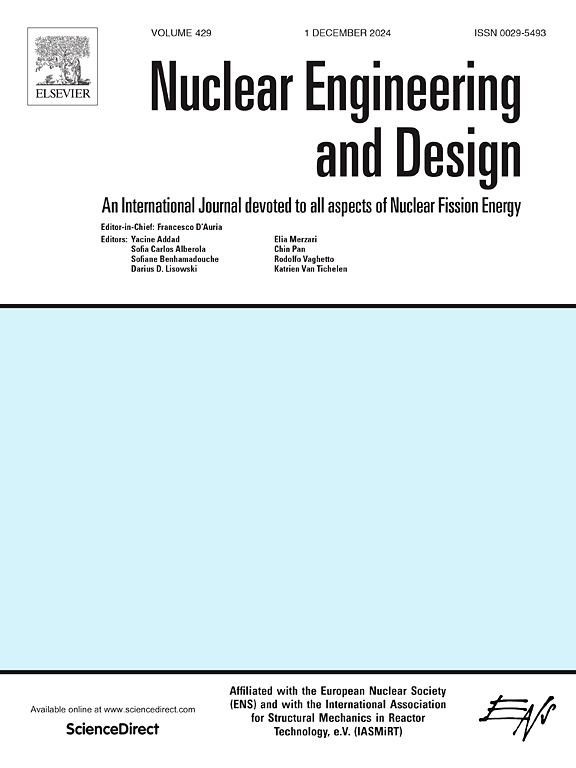Experimental investigation on the performance and characteristics of the seawater cooled PRHRS (SWC-PRHRS) under various conditions
IF 2.1
3区 工程技术
Q1 NUCLEAR SCIENCE & TECHNOLOGY
引用次数: 0
Abstract
With the introduction of carbon emission regulations by the International Maritime Organization (IMO), the development of nuclear-powered ships has become increasingly important. Among the key technologies required for such vessels, the design of a passive residual heat removal system (PRHRS) suitable for the marine environment is considered one of the major challenges. The authors previously proposed a conceptual design of a seawater-cooled PRHRS (SWC-PRHRS), utilizing seawater as the ultimate heat sink, and demonstrated its feasibility through both numerical simulations and experimental validation. In this study, the performance and characteristics of the SWC-PRHRS were experimentally investigated under various assumed conditions that may occur in practical applications. These conditions include increased flow resistance within the system, the presence of non-condensable gases such as air, operation using only the seawater heat exchanger for heat removal, inclination of the air heat exchanger, and partial blockage of airflow through selected channels of the air cooler. The study also identified the system’s optimal filling ratio and analyzed the fluid behavior in the connecting pipe between the outlet of the air heat exchanger (AHX) and the inlet of the seawater heat exchanger (SWHX), which plays a critical role in driving head generation and natural circulation. Experimental results showed that the system’s performance was sensitive to flow resistance, while the presence of non-condensable gases had a noticeable effect but remained acceptable under the tested conditions. System performance deteriorated when airflow through some air cooling channels of the cooling tower was obstructed, and SWC-PRHRS could not function using only the seawater heat exchanger. Furthermore, optimal performance was achieved when the filling ratio was within a specific range. Based on prior numerical results, the experiments also confirmed that the internal flow within the connecting pipe between the AHX and the SWHX did not exhibit two-phase behaviors such as mixture or slug flow. Instead, vapor and liquid phases remained clearly separated under gravitational influence.
不同工况下海水冷却PRHRS (SWC-PRHRS)性能与特性的实验研究
随着国际海事组织(IMO)碳排放法规的出台,核动力船舶的发展变得越来越重要。在此类船舶所需的关键技术中,设计适合海洋环境的被动余热排出系统(PRHRS)被认为是主要挑战之一。作者提出了一种利用海水作为最终散热器的海水冷却式PRHRS (SWC-PRHRS)概念设计,并通过数值模拟和实验验证了其可行性。在本研究中,对SWC-PRHRS在实际应用中可能出现的各种假设条件下的性能和特性进行了实验研究。这些条件包括系统内流动阻力增加,空气等不可冷凝气体的存在,仅使用海水热交换器进行散热,空气热交换器倾斜,以及通过空气冷却器选定通道的气流部分阻塞。研究还确定了系统的最佳填充比,并分析了空气换热器出口(AHX)与海水换热器进口(SWHX)连接管内的流体行为,这对驱动水头生成和自然循环起着关键作用。实验结果表明,系统性能对流动阻力敏感,而不凝性气体的存在对系统性能有明显影响,但在测试条件下仍可接受。当通过冷却塔部分风冷通道的气流受阻时,SWC-PRHRS无法仅使用海水换热器运行,导致系统性能下降。当填充率在一定范围内时,性能最优。基于先前的数值结果,实验还证实了AHX与SWHX连接管内的内部流动不存在混合流或段塞流等两相行为。相反,水蒸气和液相在重力的影响下仍然明显分开。
本文章由计算机程序翻译,如有差异,请以英文原文为准。
求助全文
约1分钟内获得全文
求助全文
来源期刊

Nuclear Engineering and Design
工程技术-核科学技术
CiteScore
3.40
自引率
11.80%
发文量
377
审稿时长
5 months
期刊介绍:
Nuclear Engineering and Design covers the wide range of disciplines involved in the engineering, design, safety and construction of nuclear fission reactors. The Editors welcome papers both on applied and innovative aspects and developments in nuclear science and technology.
Fundamentals of Reactor Design include:
• Thermal-Hydraulics and Core Physics
• Safety Analysis, Risk Assessment (PSA)
• Structural and Mechanical Engineering
• Materials Science
• Fuel Behavior and Design
• Structural Plant Design
• Engineering of Reactor Components
• Experiments
Aspects beyond fundamentals of Reactor Design covered:
• Accident Mitigation Measures
• Reactor Control Systems
• Licensing Issues
• Safeguard Engineering
• Economy of Plants
• Reprocessing / Waste Disposal
• Applications of Nuclear Energy
• Maintenance
• Decommissioning
Papers on new reactor ideas and developments (Generation IV reactors) such as inherently safe modular HTRs, High Performance LWRs/HWRs and LMFBs/GFR will be considered; Actinide Burners, Accelerator Driven Systems, Energy Amplifiers and other special designs of power and research reactors and their applications are also encouraged.
 求助内容:
求助内容: 应助结果提醒方式:
应助结果提醒方式:


